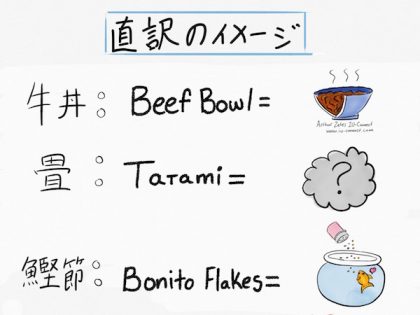外国人にオススメをするとします。
A: “You should try daifuku!”
大福を絶対に食べてみて!
B: “Daifuku, what’s that?”大福って何ですか?
A: “It’s mochi with Anko inside”餡子が入っているお餅です。
B: “… what’s anko?”
・・・餡子って?
大福、もなか、団子、日本の和菓子によく使われている「餡子」。
でも「餡子」って英語でなんというのでしょうか?
簡単に辞書で調べて、出てくる「red bean paste」をそのまま言えるかもしれません。
でもそれを聞いて外国人の相手はどう思うでしょうか?
「・・・あんまり美味しくなさそうだな。」
興味を持ってもらい、ワクワクして日本の文化を体験してもらいたいのに、
あまり魅力を感じてもらえません。
ではどうやってわかりやすく、相手に興味を持ってもらうように「餡子」を説明できるのでしょうか?
今回のコラムでご紹介します。
辞書を捨ててください
日本の文化を説明するとき、英語で言えない単語がたくさんありますよね。
そのとき、多くの方々は辞書を使います。
でも辞書に載っている定義は会話で使うと、多くの方々はおかしく感じてしまいます。
それってなぜでしょうか?
辞書に載っている言い方は「表面的な意味」が一緒かもしれませんが、イメージや感覚がだいぶ違うのです。あまり魅力を感じない、心の中で「なんか違う」と思う定義がたくさんあります。
相手に理解してもらえ、さらに魅力を感じてもらうために・・・
4つのステップを使いましょう!
以前のコラムでは、日本の文化を簡単で分かりやすく説明できるための4つのステップをご紹介しました。
それぞれのステップを使って「餡子」の自然な言い方を学びましょう!
① 辞書の単語ではなく、簡単な言葉
It’s a Japanese dessert. It’s sweet. It is made from red beans.
和菓子です。甘いです。あずきから作られます。
② 外国の文化と似ているところ
It is like peanut butter
ピーナッツバターみたいです。
③ 外国の文化と違うところ
But the taste is different.
でも味が違います。
④ どう・いつ・なぜ使うか
We eat it in traditional Japanese sweets. We eat it with mochi.
日本の伝統的な和菓子でよく使われます。よくお餅と一緒に食べます。
いかがでしょうか?「餡子」を簡単に、わかりやすく相手に興味を持ってもらえるように説明できました!
相手は「へ〜、面白そう」と思ってくれるはずです。
例文に依存しすぎないでください
ここでご紹介した言い方は多くある中のただ1つの言い方にすぎません。実は4つのステップに従えば、他にも言える文章を自由に作れます!
例えば:
①It’s a traditional Japanese dessert. It’s red.
② It’s like a paste.
③ But it’s sweet.
④ It’s a very popular sweet in Japan.
他に言える方法もたくさんあります!
自信を持って、ぜひ自分なりに説明してみてください。
何より、笑顔を忘れないで下さいね!
他の日本の文化を英語で伝えたいと思いませんか?
I’m looking forward to your comments!
アーサーより


Hello, Arthur and everyone!
Thank you for the great tip, Arthur. This idea can be used when I explain some traditional Japanese words to my friends who are from other countries.
Simple is best. I’ll try doing it.
Hi Arthur!! I agree your idea about that because I major in education and know how difficult explaining something so I admire your opinions.
that is exactly what I wanted to expess!
thanks a lot!
こんにちは アーサーさん
「あんこ」のような日本にしかないものを英語で説明するのは難しいですが、アーサーさんのおっしゃる通り、簡単な英語で、相手の国にもあるようなイメージしやすいものに「似ている」と説明すると、わかりやすいようですね。
実際に海外からの旅行者に日本的なもの、たとえば「餡子」「山椒」「だし」「みりん」などを説明する時にはイメージを共有できるようにとにかく簡単な単語を、簡単な文法でつなげると大体伝わります。
日本的なものを説明するときに、英語での表現以外に重要な要素があります。それは、「日本語でそれを説明できるか」です。「みりん」などは日本語で子供でも分かるように説明するのは少々難しいのではないでしょうか?日本人自身が日本文化をよく学ぶ必要もありますね(笑)
私は外国人とよく居酒屋に行くのですが、「醤油をかける、つけるの違い」「刺身の『つま』は食べるのか?」「みょうがって何?」「ゆずこしょうはpepper?」などよく聞かれます。
アーサーさんのレッスン動画なども参考にして、苦戦しながらも楽しく会話しています。
これからも役に立つ情報を期待してます!!
KEISUKE
Sorry, now I find it simpler way,
Anko is a paste, have brown black look, and tastes sweet.
It’s traditional food and ingredient for season sweets and ordinal extra sweets as known wagashi for our guests welcoming.
We can eat wagashi at tea ceremony as it like tea party in Japan, too,
It is served with matcha tea bowl and drink and eat in quietary.
Thank for reading and hope it you will enjoy them trying too^_^
Hi, Arthur! Nice getting with you, greatly thankful to your posting new topic!
Now then, I’d confessed I had tried to express Japanese traditional food in previous writing, that proved to failed to tell in precise to my English teacher what is Anko.
Well, I was asked to give writing not precisely in detailed but more than simple and concise, to use expressions where it is used in English spoken.
So today’s excercise is very good and and understandable.
Anko, is a kind of traditional food used often in seasonal Japanese sweets.
It looks brown black, made from Azuki pastesーa paste from red beans.
Anko is a popular name, and we usually seen wagashi in wagashi corners at groceries, and even in convenience stores,
It’s so sweet and decorative or simple cute to look,
Coz wagashi is a vital to good appetitive to a momentous glance!
It’s so beautiful!!”
Anko is a star of wagashi gradients, and often used with mochi as kochi gashi,
We called it, with kochi and Anko combination.
Daihuku, is one excellent spark to use it both.
It is named to hope it calls for Fuku,, equally to name as happiness in Japanese.
Let you have it tried, then, a piece of one Anko sweet.
I like it too, from my childhood .
Thanks for reading all.
Some of all mistakes, deprived writing from mine is, responsible to me.
Ellie
An
So
Sorry, about above,
Mochi gashi , is correct.
ingredient, is correct as same as above.
Sorry for again.
Hey Elli!
コメントありがとうございます!
詳しい説明ありがとうございます!
忘れないでください。説明することって何より相手にイメージしてもらうことが最も大事なことです。短い方が相手に伝わりやすいかもしれません。ぜひ外国人との会話で日本の文化を教えてください。
応援しています!
アーサー
Hi, Arthur! I used to explain “anko” to my friends, like this..
Anko is very similar to marzipan, but made from red beans. We use it very often both in traditional desserts and cakes:)
Most of my foreign friends are from Europe, and they love marzipan!
I’m not sure marzipan is so common in USA, though..
Peace, akemi
Hey Akemi! Thats a great example! But like you said, Marzipan isn’t common in the USA.
Actually, I don’t know what Marzipan is, haha!